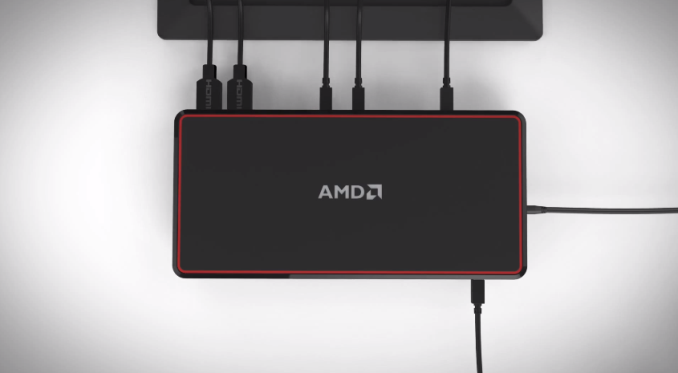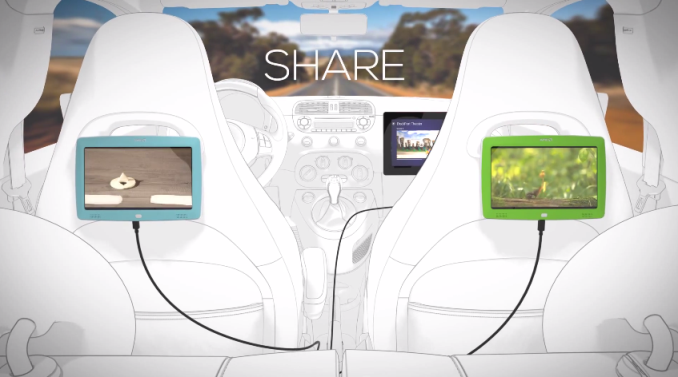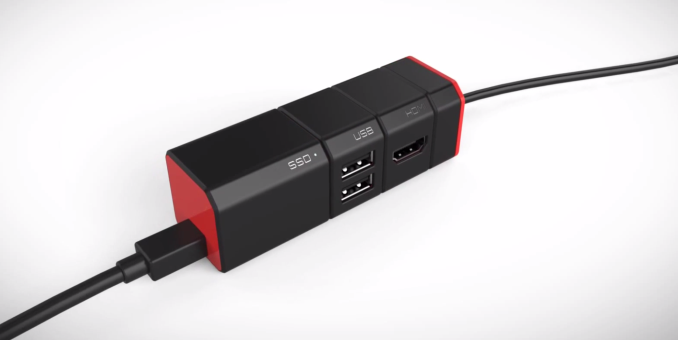AMD’s DockPort Given Virtual Overview
by Ian Cutress on February 13, 2014 4:58 AM EST- Posted in
- AMD
- DisplayPort
- DockPort

Flying somewhat under the radar, DockPort from AMD is designed to be a low-cost all-in-one solution for external connectivity for a PC or tablet. Sound familiar? Like Thunderbolt familiar? This is AMD’s solution to the issue of connectivity, using the DisplayPort connector to transfer USB information as well as audio/visual.
Not a lot has been said about DockPort, despite originally being given a name sometime in 2012, but since CES 2014 has been adopted as an official DisplayPort standard extension by VESA with a finalized standard expected in Q2. With the combination of DisplayPort and USB 3.0 over a single cable, AMD’s video explains it best how it can be used:
To list the possible uses:
- Charging (over USB 3.0 standard we would assume)
- Docking to an external keyboard/battery/audio
- Connecting Storage, Audio outputs, Video outputs, USB hubs
- Share video or run multiple video screens
Basically this is everything USB can do, including video stream via DisplayPort, albeit in a single interface that is already standard across many systems and form factors. AMD have not specified what extra hardware is needed beyond DisplayPort compatibility (presumably the next iteration of the DisplayPort standard) or whether this extension is just for limited use with a bridge chip. DockPort verified cables will be needed, and no idea on the cost of those this early in the development cycle, or whether the standard will be roped into DisplayPort fundamentally. The main competition is of course with Intel's Thunderbolt, where one of the features I am most looking forward to is Graphics over TB. That will not be possible with DockPort, but it will try to do everything else it seems, although it does seem to suggest that DockPort will be limited to USB 3.0 for any data-related daisy chaining, unless AMD have an ace up their sleeve.
I would imagine AMD would tie this technology into their desktop motherboard line, as well as their SoCs, when it is ready which might increase adoption rates faster than Thunderbolt. Having both interfaces use a similar sort of connector asks the question whether the two interfaces might be coherent in the same output/input, making future devices (namely storage) able to use both in one connector rather than have specific DockPort/TB inputs.
This is still early days, given the computer generated nature of AMD’s video. Computex is still several months away – we might see an real world update then. Looking forward to it…!


















52 Comments
View All Comments
TEAMSWITCHER - Thursday, February 13, 2014 - link
Did you ever see the Family Guy episode where Stewie made an f'ed up clone of himself he called "Bitch Stewie?" AMD has just made "Bitch Thunderbolt."BMNify - Thursday, February 13, 2014 - link
remember Intel Light Peak ? then Thunderbolt is also a "Bitch Light Peak" OC that's been 4 years so we should be seeing real Si Photonics soon, even if its Only as a data carrier and not the real deal Si Photonic processingrepoman27 - Thursday, February 13, 2014 - link
Yeah, but I also remember that Light Peak had nothing to do with silicon photonics. It used conventional VCSELs for the external transceivers instead of the copper versions that Thunderbolt uses, but the host controller was more or less identical. Why is it that people have such a hard-on for lasers? Did everyone think that TOSLINK was the best interconnect standard ever or something?It's more like AMD just made "Bitch MHL", although on second thought, I'm not sure who would be the bitch in that situation.
edzieba - Thursday, February 13, 2014 - link
"Sound familiar? Like Thunderbolt familiar?"Actually, sounds familiar, like OneLink familiar. Lenovo's docking port is really a power connector and displayport connector carrying an extra USB3 link for ethernet and port breakout on an internal hub.
Little chance it'll be compatible with DockPort though, particularly with the price of OneLink docks outside of the US.
repoman27 - Thursday, February 13, 2014 - link
I'm surprised that Anandtech, of all places, still isn't reporting how DockPort actually works, all of which is detailed on TI's website: http://www.ti.com/lit/ds/symlink/hd3ss2521.pdf?DCM...The bottom line is that it requires a chip on the host PC which simply muxes the SuperSpeed USB send and receive pairs with lanes 2 and 3 of a DisplayPort 1.2 main link. It also uses the DisplayPort CONFIG1 and CONFIG2 lines for the USB 2.0 signal, and has provisions for power delivery. If the attached devices use SuperSpeed USB, it will only have a 2-lane DP link running at 5.4 Gbit/s, which is effectively the same bandwidth as DP 1.1a. If you want to connect more than one display to a single port, you need to include a relatively spendy DP 1.2 MST hub in the device. All USB devices will be sharing the 500 MB/s bandwidth of a single USB 3.0 port (or less, depending on what else is connected to the host controller), or a paltry single USB 2.0 port if more than 2 DP lanes are required. All DockPort cables will be captive to the device per VESA requirements.
This is not at all like Thunderbolt, which is a 4-channel, 10.3125 Gbit/s serial I/O controller which supports daisy chaining and can transport PCIe, DisplayPort and TCP/IP packets along with 10 W of power over dual-channel links.
SirKnobsworth - Thursday, February 13, 2014 - link
They'll probably bump to DisplayPort 1.3 and USB 3.1 in the not-too-distant future, which will alleviate some of the capacity constraints. It's never going to keep up with Thunderbolt's active cabling and more involved signal routing but it will be cheaper, and probably simpler to implement.SilentSin - Thursday, February 13, 2014 - link
Given how cheap it is to implement this tech I think OEMs will run with it (unless "forced" to do otherwise). http://www.anandtech.com/show/7649/dockport-adopte...Check out the chip in the Acer V5 which was released a long time ago...part # seems eerily similar as does the functionality. http://semiaccurate.com/forums/showpost.php?p=2055...
The modular parts in the youtube video look pretty awesome. I do wish AMD could launch some of those products to retail along with what was shown at CES. I'm sure OEMs will use some of the ideas eventually, but they always seem to screw up at least one key aspect.
repoman27 - Thursday, February 13, 2014 - link
The chip in that Acer V5 is in fact the same TI DockPort controller which I linked to the datasheet for earlier. I have a feeling that DockPort will mostly be implemented by OEMs who also offer branded adapters and docks, as Acer does: http://store.acer.com/store/aceramer/en_US/pd/Them...The modular accessories are masking the fact that DockPort cables must be captive, so making the cable zero length would result in little thumb drive like modules. You never tend to see USB thumb drives with integrated USB hubs so that they can be stacked together in that way though, so I'm not sure what would make that paradigm take off.
goozira - Thursday, February 13, 2014 - link
I'm just wondering how DockPort sends data. Say if I have a RAID storage box, can it send the data across the Displayport side or would it only send data using USB 3.0 and it would be limited to USB speeds.repoman27 - Thursday, February 13, 2014 - link
DockPort sends data using USB 3.0. It's literally just a few switches and some logic that allow a DisplayPort 1.2 port and a USB 3.0 port to share the pins of a standard MiniDP receptacle. It also has provisions for power delivery that are similar to the USB Power Delivery Specification.DockPort is about reducing the number of cables required to connect certain types of devices by 1 or maybe 2. It introduces no new features and yet makes several compromises along the way.